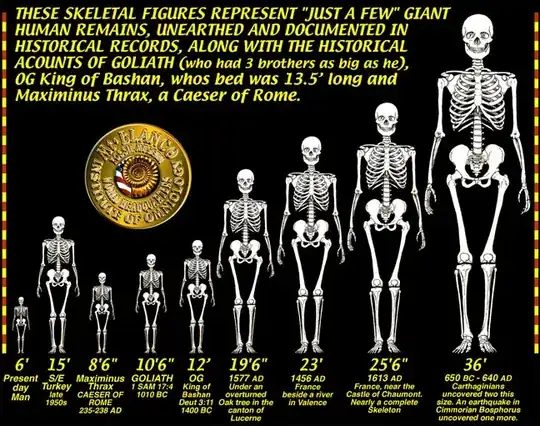This article shows a diagram of the remains of human giants . The tallest one being 36 ft. (1097.28 cm.) This seems like a pretty large claim for an article that doesn't state any sources. Could there be any legitimacy to these claims?
. The tallest one being 36 ft. (1097.28 cm.) This seems like a pretty large claim for an article that doesn't state any sources. Could there be any legitimacy to these claims?
- 140,378
- 46
- 548
- 638
- 303
- 2
- 5
-
5To quote A.R. Tesla, "Why do we even *have* the [Square-Cube Law](http://en.wikipedia.org/wiki/Square-cube_law) ?" – Shadur Jun 16 '14 at 09:08
-
Also not the sources that are cited are quite old and most of them unlikely to be verifiable. I do however think that if a 15' skeleton had been found in the 1950, it should still be around somewhere. – drat Jun 16 '14 at 10:44
-
1For future reference, the word ["cryptozoology"](http://en.wikipedia.org/wiki/Cryptozoology) is an indication that anything to follow is almost certainly total crap. These are the folks who look for Bigfoot and the Loch Ness monster and Yetis. The presence of the suffix `-ology` is supposed to make it seem more scientific, but it's pseudo science at best. – HopelessN00b Jun 16 '14 at 10:45
-
Related: http://skeptics.stackexchange.com/questions/8731/was-there-a-giant-red-haired-race-in-north-america?rq=1 – Jamiec Jun 16 '14 at 11:20
-
1@HopelessN00b I wouldn't say "total crap" but usually you need examine anything with the label with a very skeptical eye. – rjzii Jun 16 '14 at 12:50
-
6Possible explanation that might improve any answers: Were there any fossil discoveries (eg, dinosaur bones, incomplete skeletons) that were _mistaken at the time of discovery_ for gigantic hominids? – Brian S Jun 16 '14 at 14:56
-
2The fact-checking on this article didn't even extend to looking to see if "Caesar" was spelled correctly. Twice. – DJClayworth Jun 16 '14 at 15:44
-
Closest I've found of something reputable is http://en.wikipedia.org/wiki/Giant_of_Castelnau which was a small number of bones of extreme proportion. The Wisconsin find in 1912 was reported in several newspapers, but no pictures or corroborating details. There are, of course, isolated figures of 9-10 feet found, but that's well within human norms. – Sean Duggan Jun 16 '14 at 16:12
-
Hah! And the site at http://atrueott.wordpress.com/forbidden-archeology/ links to http://news.nationalgeographic.com/news/2003/02/0205_030205_cyclops.html as claiming discovery of "15 foot tall cyclops" when the NG article is all about a find of mammoths that may have confused the Greeks into making up the cyclops! – Sean Duggan Jun 16 '14 at 16:15
2 Answers
No. There is no fossil evidence of any apes being larger than about 9.8ft tall.
"The fossil record suggests that individuals of the species Gigantopithecus blacki were the largest known apes that ever lived, standing up to 3 m (9.8 ft)." (Refs: Wikipedia, McMaster University).
-
As per the comment by @BrianS in the question itself, is there anything in the historical record of skeletal discoveries at the times indicated that could be an explanation. In other-words, where skeletons of any time found in the cited time frames? – rjzii Jun 16 '14 at 15:11
Adding to Articuno's answer, the reason no remains of the type have been found is because adult hominids taller than (about) 9 feet simply can't exist.
It's about physics: If you double the height of any being, its surface area quadruples, and its volume triples. While lengths scale linearly (x), areas scale quadratically (x^2) and volumes scale cubically (x^3). This means that a human as big as those in your examples would not reach adulthood.
The oldest remains of a person with gigantism are those of a man that lived close to Rome in third-century A.D. Gigantism itself is extremely rare (about three people in a million worldwide today).
'Giants' can't exist because it's a scaling issue. Galileo was one of the first to point it out:
Galileo begins “Two New Sciences” with the striking observation that if two ships, one large and one small, have identical proportions and are constructed of the same materials, so that one is purely a scaled up version of the other in every respect, nevertheless the larger one will require proportionately more scaffolding and support on launching to prevent its breaking apart under its own weight.
If you double all the dimensions of a stone building supported on stone pillars, the weights are all increased eightfold, but the supporting capacities only go up fourfold. This all applies to animals and humans too:
(Large) increase in height can be accomplished only by employing a material which is harder and stronger than usual, or by enlarging the size of the bones, thus changing their shape until the form and appearance of the animals suggests a monstrosity.
If humans were to be doubled in size, for example, their shape would need to change so much they would hardly be considered the same species.
- 1,576
- 15
- 20
-
2This is a good start, but the fact that a maximum size for humans to survive at *exists* doesn't prove that that size is 9 feet. Why is 9 feet the cut-off point? – Brendan Long Aug 21 '14 at 20:24
-
1*If you double the height of any being, its surface area quadruples, and its volume **triples**.* What ? In my notebook the volume is multiplied by eight, not by three. Must be carelessness because below you correctly mention weight being increased *eightfold*. – Evargalo Feb 14 '18 at 15:26